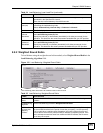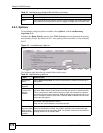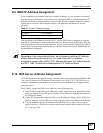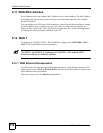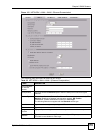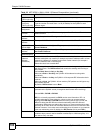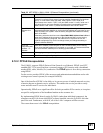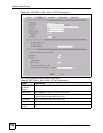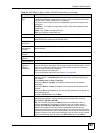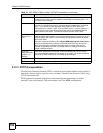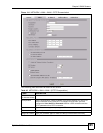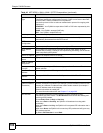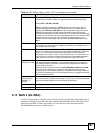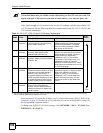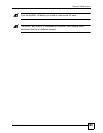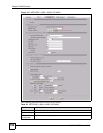
Chapter 8 WAN Screens
ZyWALL 2WG User’s Guide
183
Authentication
Type
The ZyWALL supports PAP (Password Authentication Protocol) and CHAP
(Challenge Handshake Authentication Protocol). CHAP is more secure than PAP;
however, PAP is readily available on more platforms.
Use the drop-down list box to select an authentication protocol for outgoing calls.
Options are:
CHAP/PAP - Your ZyWALL accepts either CHAP or PAP when requested by this
remote node.
CHAP - Your ZyWALL accepts CHAP only.
PAP - Your ZyWALL accepts PAP only.
Nailed-Up Select Nailed-Up if you do not want the connection to time out.
Idle Timeout This value specifies the time in seconds that elapses before the ZyWALL
automatically disconnects from the PPPoE server.
WAN IP Address
Assignment
Get
automatically
from ISP
Select this option If your ISP did not assign you a fixed IP address. This is the
default selection.
Use Fixed IP
Address
Select this option If the ISP assigned a fixed IP address.
My WAN IP
Address
Enter your WAN IP address in this field if you selected Use Fixed IP Address.
Advanced Setup
Enable NAT
(Network
Address
Translation)
Network Address Translation (NAT) allows the translation of an Internet protocol
address used within one network (for example a private IP address used in a local
network) to a different IP address known within another network (for example a
public IP address used on the Internet).
Select this checkbox to enable NAT.
For more information about NAT see Chapter 17 on page 385.
RIP Direction RIP (Routing Information Protocol) allows a router to exchange routing information
with other routers. The RIP Direction field controls the sending and receiving of
RIP packets.
Choose Both, None, In Only or Out Only.
When set to Both or Out Only, the ZyWALL will broadcast its routing table
periodically.
When set to Both or In Only, the ZyWALL will incorporate RIP information that it
receives.
When set to None, the ZyWALL will not send any RIP packets and will ignore any
RIP packets received.
By default, RIP Direction is set to Both.
RIP Version The RIP Version field controls the format and the broadcasting method of the RIP
packets that the ZyWALL sends (it recognizes both formats when receiving).
Choose RIP-1, RIP-2B or RIP-2M.
RIP-1 is universally supported; but RIP-2 carries more information. RIP-1 is
probably adequate for most networks, unless you have an unusual network
topology. Both RIP-2B and RIP-2M sends the routing data in RIP-2 format; the
difference being that RIP-2B uses subnet broadcasting while RIP-2M uses
multicasting. Multicasting can reduce the load on non-router machines since they
generally do not listen to the RIP multicast address and so will not receive the RIP
packets. However, if one router uses multicasting, then all routers on your network
must use multicasting, also. By default, the RIP Version field is set to RIP-1.
Table 39 NETWORK > WAN > WAN 1 (PPPoE Encapsulation) (continued)
LABEL DESCRIPTION



